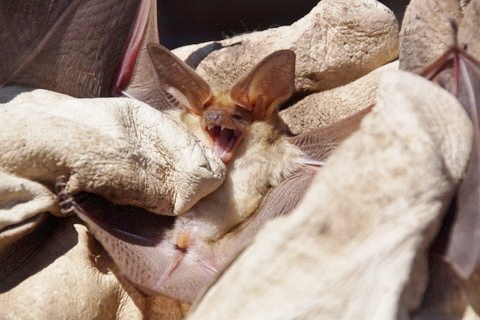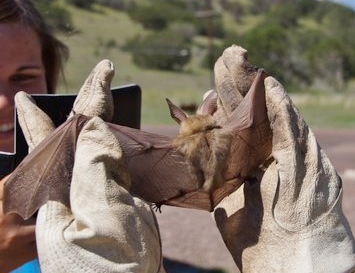

Myths and facts about the beneficial bat
by Jolaine Lanehart, Texas Master Naturalist
Many people think bats are dirty, rabies-infested, and evil. Bats are very clean, grooming themselves constantly. They do not carry rabies but, like most mammals, they can become infected. Bats will not attack humans nor get tangled in your hair.
As members of the order of Chiroptera (meaning ‘hand-wing’), bats are the second largest group of mammals and constitute one-fourth of all mammals. Texas has 33 of the 40 United States species.
We know that bats consume tons of insects during their nocturnal flights, eating about ¾ of their body weight. At Bracken Cave, it is estimated that 20 million bats eat 200 tons of insects nightly.
Bats are major pollinators of over 300 species of fruit. Their facial features precisely fit into night blooming plants, such as agave. Some plants, such as cacao are dependent upon bats for propagation. Bats consume the cacao beans and distribute the beans through digestion.
Many bats live in colonies wedged into crevices. These bats are typically dark brown, have one pup a year, and maintain communal nurseries. Other bats roost in foliage and are reddish brown, resembling dead leaves. These bats live singly, except during mating. Foliage bats will have up to four pups.
Bats breed between August and October. Gestation is typically 45 days. The female can save the sperm during hibernation or migration and use it later to fertilize eggs. Bats can live 25 to 40 years.
Threats to bats include accidental grounding, white nose syndrome, and wind turbines. If you find a live bat on the ground, get a cardboard shoe box, and, using gloves, gently scoop the bat into the box; and contact the zoo. White nose syndrome, introduced by cavers, is a fungus that grows in the cold. Hibernating bats will scratch the fungus, loose body heat and stored energy, and starve as a result. One study found that wind turbines caused the loss of 6 million bats. Turbines turn at 125 mph creating suction that causes the bat’s lungs to collapse. Running the turbines during periods of high winds, when bats aren’t flying, significantly reduces bat mortality.
The Rio Grande Valley Chapter Texas Master Naturalist develops knowledgeable volunteers dedicated to the study and conservation of natural resources and natural areas in the Lower Rio Grande Valley and helps the natural world through service, outreach and education.
